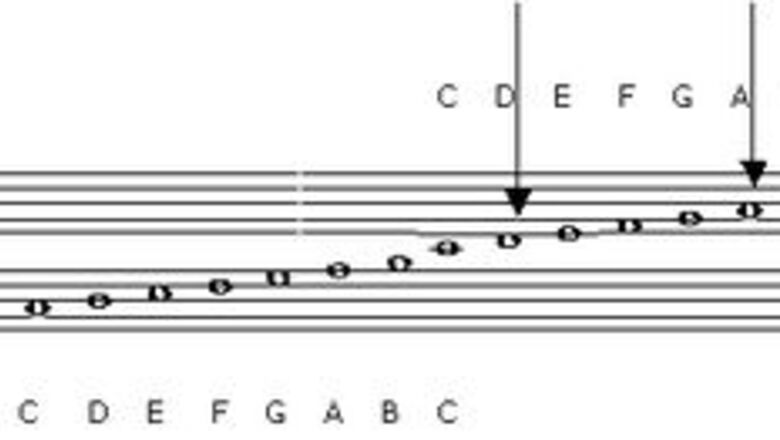
views
It has but three strings and two are tuned to the same pitch (except one octave higher). This is both a limiting factor and one that opens up tremendous possibilities. Less is more, more or less.
An understanding of the tuning, a few scales, and a few simple chord progressions can ease your way into enjoying this complexly simple instrument.

Tune the 3-string Cigar Box Guitar to the Key of D (My Father's Tuning - DAD). There are eight notes between the low D and High D' strings (an octave).
For review: It is Every Good Boy Does Fine on the lines (EGBDF), and FACE on the spaces. On the Bass clef it is Good Boys Do Fine Again and ACE G on the spaces.

The C Major scale has no sharps or flats. There is a whole step (skip a fret) between everything except B&C and E&F (1/2 step or next fret up). From C to C' there is a pattern: W, W, H, W, W, W, H, where W=Whole step (skip a fret) and H=Half step (next fret up).

However, to maintain this same step pattern when starting on the D note, the key of D has two sharps; F# and C#. To play a D Major scale (from low D to high D') follow this second pattern. Practice this pattern with "finger fretting" and also with a slide.
The key of G has only one sharp (F#). Similar to the above pattern, except the C is a natural - fret above the B. Start in the 5th fret on G, then play the notes up to high G.In Western music many chords are made up of a triad; the 1st, 3rd, and 5th notes of a scale. Due to the limitations of this instrument (only 3 strings), a chord is made of the 1st and 5th notes in the scale. For example, an A chord is composed of A and E (and A'). This means a barre placed across the 3 strings will make a chord. Use a glass or steel slide to form the barre (or lay one finger across all three strings). Place the slide directly above the metal fret wire to make a crisp note. Keep the slide parallel with the frets when you move it. Pick a note, then slide a fret or two up or down the neck to the next note.

Practice a progression in the key of G.

G chord 5th fret
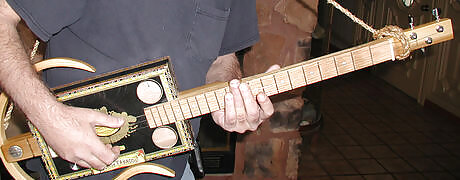
C Chord 10th fret

G chord 5th fret
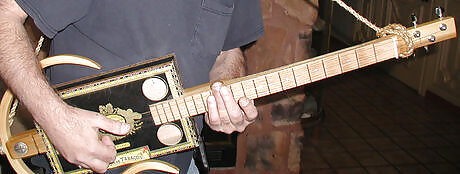
D Chord 12th fretThough difficult to see, there is a glass slide on the ring finger. Play G (5th fret), C (10th fret), G (5th fret), D (12th fret), G, C, D, C, G or variations thereof.
A classic Chord Progression: Place the slide directly above the metal fret at the 12th position, strum or finger pick 1,2,3,4 beats and move the slide to the next position. Frets: 12th, 9th, 5th, 7th, 12th… repeat three more times; follow-up with a turn-around... 12th, 14th, 12th, 7th, 9th, 11th, 12th.
The progression is what the left hand would play on a piano. See if you can find the individual notes to a melody that may go to this familiar progression. [Hint: Heart & Soul or Silhouettes on the Shade.]

Experiment to find other three or four chord progressions. G, C, G, D... The fret numbers are given for the key of D, figure out the fret number for the same progression in the other two keys. Play the 4 chord progression four times, then follow up with the turn-around.
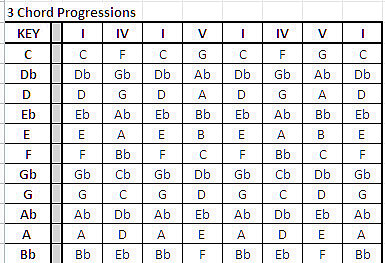
Many 3 Chord progressions (1st, 4th, 5th)3ChordProgressions.PNG

Many 4 Chord progressions, with "turn-around" (8th, 6th, 4th, 5th).
Tablature: There are probably few examples of Cigar Box Guitar tablature, here is one blues scale riff... The lines represent the strings (fat string at the bottom), the numbers represent the fret to put your finger or slide in.
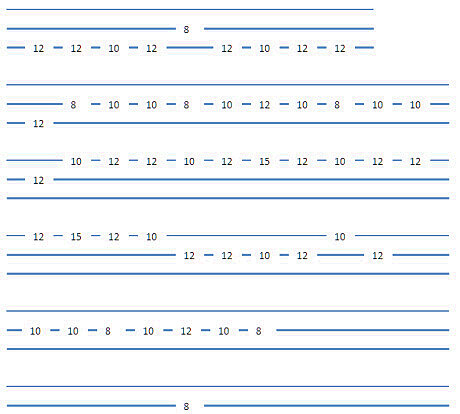
This progression came from a guitar booklet called Basic Blues by Will Schmid.















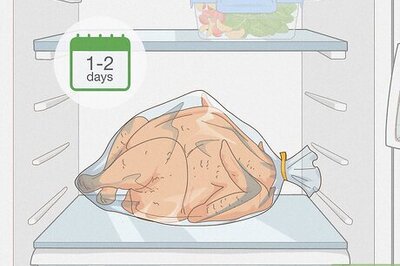
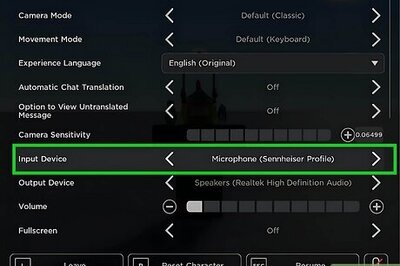


Comments
0 comment